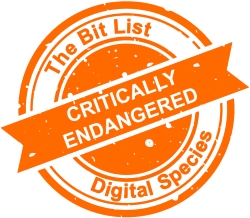Commercial Software
 |
||
|
Computer software that is produced for sale or that serves commercial purposes, including previous editions and versions of software that are not available or no longer in use. This entry broadly includes proprietary software, access through licences or subscription business models. |
||
|
Digital Species: Software |
Trend in 2024:
|
Consensus Decision |
|
Added to List: 2023 |
New Entry |
|
|
Imminence of Action Action is recommended within three years, detailed assessment within one year. |
Significance of Loss The loss of tools, data or services within this group would impact on many people and sectors. |
Effort to Preserve | Inevitability Loss seems likely. By the time tools or techniques have been developed, the material will likely have been lost. |
|
Examples Wordstar, Novell Netware 386, SAP, Oracle, Adobe Photoshop; Microsoft products, such as the Windows Operating System and MS Office, are some of the most well-known examples of commercial software. |
||
|
‘Practically Extinct’ in the Presence of Aggravating Conditions Lack of skills, commitment or policy from corporate owners; lack of established frameworks and tools; technology is poorly understood; no emulation pathway; reliance of proprietary software and/or subscription-based business models; limited or no commercial interest; complexities of sector-specific software or data types; lack of technical documentation; uncertainty over IPR or the presence of orphaned works; technical protection measures that inhibit preservation actions; encryption. |
||
|
‘Endangered’ in the Presence of Good Practice Effective replication; access to source code; emulation pathway; strong technical documentation; preservation pathway; licensing that enables preservation; use of open formats and open source software; corporate preservation capability; awareness and advocacy work with commercial software providers. |
||
|
2023 Review This was a new Bit List entry added in 2023 to draw attention to the particular challenges of content and software preservation for commercial software products. The entry focuses on the distinct risks relating to the availability and access to software and code, and lack of preservation interest or mandate, by companies that publish them, creating challenges to preserve digital content and software in source code form. The entry also highlighted that software, as a whole, was not currently on the list (compared to higher-level species like Apps). The Council agreed on the creation of a new higher-level Software digital species group to address this gap and challenges specific to software preservation while also recognizing overlaps with other entries including Apps, Gaming, Media Art and Research Outputs. While there are overlaps, the Council agreed it would be valuable to separate software to reflect differences in the volume of access to software, significance and motivations for preserving commercial software in and across different sectors. |
||
|
2024 Interim Review These risks remain on the same basis as before, with no significant trend towards even greater or reduced risk (‘No change’ to trend). |
||
|
Additional Comments A large part of this requires advocacy work, and call to action to raise awareness with commercial software providers to preserve their software. Software preservation raises (often debated) questions about key characteristics for preservation. Wordstar, for example, may be of interest for not only access to the content it facilitates but also for the preservation of the software as mass produced, commercial product. You can also argue in more practical ways that for most files there is usually something about them that you need for the original software for or else the content will be different, and therefore preservation of software is critical regardless of the significance of the software as a product. Software dependencies on the environment (hardware and software) enable it to run and its associated context and support and in this way some of the approaches can overlap with gaming, but software is not seen as a creative product in the same way. This nomination is more about commercial uses and industrial design objects where games are artworks for entertainment and social/cultural uses. One might argue the contents of the Museum of Brands and Packaging is not unique and yet it seems unsafe to expect it to necessarily exist elsewhere. The low regard in which commercial software (and this is before we consider bespoke research software) is held - except as a means of accessing more interesting material - seems to suggest that we may in the future look in vain for someone with a copy of even quite widely available software, let alone, say, early UK antivirus products, world leading as they were. Case Studies or Examples:
See also:
|
||









































































































































